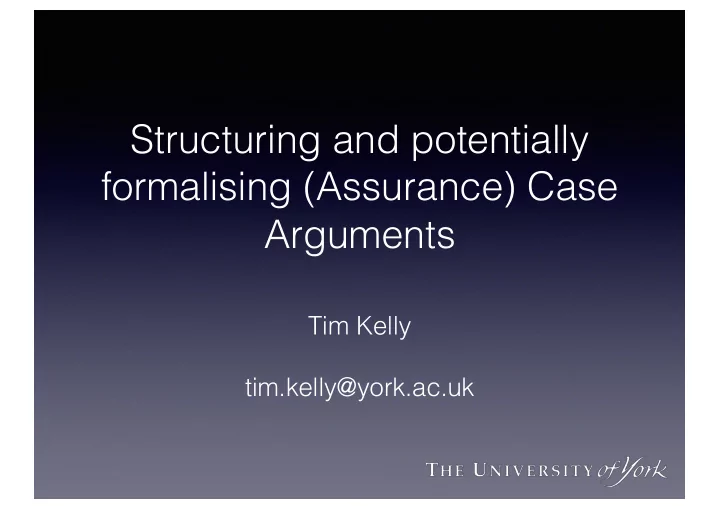

Structuring and potentially formalising (Assurance) Case Arguments Tim Kelly tim.kelly@york.ac.uk
Overview • Safety Cases and Safety Arguments • Structured (but Informal) Arguments • Considerations in Formalisation • Structured Assurance Case Metamodel (SACM)
Safety Cases • The purpose of a safety case can be defined in the following terms: A safety case should communicate a clear, comprehensive and defensible argument (supported by evidence) that a system is acceptably safe to operate in a particular context • Communication is an important aspect
Synthesis of Evidence Software (Dynamic) Test Results • Analysis System • In-Service Fault Data • Examples CVs • Procedures • Human Reviews • Failure Modes and Effects Analysis • Timing Analysis • Static Code Analysis • Hardware – software testing • Simulation results … •
Three types of argument • (Causal) Behavioural arguments of ris risk management, i.e. how the causes of hazards are eliminated or mitigated, or how the consequences of hazards are mitigated. • Confidence arguments – arguments that provide confidence in the adequacy of the details of the risk management argument, e.g. justifying the adequacy of hazard identification techniques, or the sufficiency of verification results presented. • Arguments of conformance / compliance with safety standards, regulations, and legislation – where compliance is not straightforward it is necessary to justify how a project, system design and operation have addressed legal and regulatory obligations.
Arguments • Historically, narrative text commonly used • Shared understanding? • Structured Argumentation Approaches • GSN - Goal Structuring Notation, CAE etc. • GSN clearly disambiguates the structure and elements of the argument, it cannot ensure that the argument itself is ‘good’ or sufficient for its purpose
GSN Example
Supporting Informal Arguments • Deductive arguments (Formal Logic) • if the premises are true, then the conclusion must also be true • Inductive arguments (Informal Logic) • the conclusion follows from the premises not with necessity, but only with ‘probability’
Formalising the Informal • Growing interest in how these informal safety arguments may be modelled in formal logic • The informality of the underlying reasoning present in safety assurance cannot be eliminated • e.g. justification of the domain experience of personnel involved in hazard analysis • However, the informal arguments can be represented by formal logic
Inductive -> Deductive? • formalisation can involve axiomatising (informal) aspects of the argument at the 'edge' of our argument • e.g. ‘all hazards identified’ argument • Of course, could structure this further • Kicking the can down the road? • Further set of axioms covering the informal aspects of the formalised argument
Are all types of safety case argument equally amenable to formalisation? • valuable service has been performed by 'annexing' the informal arguments to an easily identified location (a form of reductionism)? • concern: illusion of formality created through hiding problematic informal and subjective arguments behind an abstraction • formalised ‘core’ with informality pushed to the periphery of the formalisation is advantageous or dangerous for evaluation and review? • formalisation will not reduce perhaps the most significant aspect of the review burden – namely individual review and acceptance of subjective (informal) assertion
Does the subject matter of a safety case argument affect the value of formalisation? • deductive arguments can form part of a safety case • when subject matter domain is itself logical • asserted inferences can become provable inferences • When safety case arguments (or at least portions of them can become provable) are they perhaps not better represented as evidence (i.e. proof), rather than as informal logic? • value of a safety case is to represent the informal logical ‘glue’ that pulls together different forms of the evidence (including deductive results – proof being one such example)
Supporting Model Based Safety Cases Systems Assurance Task Force • within the OMG (Object Management Group) has been developing a standard for the interchange ‘model’ of assurance cases for 10+ years First ARM (Argumentation • Metamodel) + SAEM Software Assurance Evidence Metamodel Then SACM 1.0 in 2012 • Them SACM 2.0 in 2018 •
SACM 2.0 Ba Base Pack Packagi aging ng Ter Terminol nology ogy Ar Artefact Ar Argumentation
Supporting Dialectic Arguments • Neglected aspect of assurance cases • Dialectic argumentation is healthy
Supporting Confidence Arguments • Example: Argumentation about the adequacy of the claims, inferences, evidential links
Supporting Modularity / Packaging • Modular assurance case management: Managing the division of assurance case arguments and evidence into modules / packages • E.g. aligned with architecture, or with supply chain
Supporting Patterns Patterns are abstract • argument structures with appropriate constraints E.g. long history in • GSN (1997) Useful to capture • reusable, ‘typical’ argument structures Patterns in SACM • generalised beyond simply argumentation (also Artefact and Terminology)
Example: GSN Patterns
Example: Artefact Patterns
Example: Expression Patterns
Supporting Machine Processing • SACM models are machine processable • Standardised format for model interchange • But reasoning is limited by ability to process expressions
Supporting Structured Natural Language
Support beyond Natural Language • MultiLangString could support several ‘dialects’ • Formal expressions • OCL (e.g. for ImplementationConstraints) • Languages that could support machine evaluation • Powerful combination with abstract argumentation, and evidence, structures (and appropriate ImplementationConstraints)
SACM Concrete Syntax
SACM Diagrams
Summary • Safety case arguments are often informal • growing interest in formalisation,, • Some discussion points: • value gained over merely ‘structured’ (model-driven) approaches • tradeoffs between precision and accessibility • whether all forms of argument are equally amenable to formalisation • SACM 2 Designed to support all of current (e.g. GSN) practice but not limited to it (e.g. dialectic, better packaging, more support for patterns) • Attempting to pave the way towards machine readable and processable arguments
Recommend
More recommend